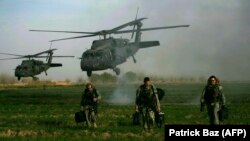KABUL -- NATO celebrated its 70th birthday this week in Washington, D.C., but the transatlantic alliance is still engaged in one of its largest and most complex missions thousands of kilometers away in Afghanistan.
Since 2003, hundreds of thousands of troops and civilians from 29 NATO member states and 21 allies have rotated through Afghanistan to provide security, reconstruction assistance, and training for Afghan security forces.
As the alliance’s leaders now look toward a possible exit from Afghanistan in the wake of peace talks, Afghans offer mixed personal views on NATO’s mission in their war-torn country.
“This war [in Afghanistan] dragged on for 18 years because of the mistakes our governments, NATO, and the United States made,” said General Sher Muhammad Karimi, a former chief of staff of the Afghan Army. “The war in our country should not have dragged on for so long. It should not have gone on for 18 years.”
Karimi, a graduate of the prestigious Sandhurst military academy in the United Kingdom, says a lack of coordination between Afghan and NATO forces, civilian casualties, and the alliance’s failure to address cultural issues prolonged the war, which mainly consists of a rural insurgency and terrorist attacks in Afghan cities.
Qudratullah Zwak, a Kabul-based analyst, likewise offers a negative prognosis. “NATO didn’t meet the expectations attached to a military alliance,” he told Radio Free Afghanistan. “The war here could not be won on the battlefield alone because it has other dimensions.”
Many Afghans agree that the most crucial element of the war in Afghanistan is the role of their landlocked country’s neighbors. Since late 2001, successive Afghan governments have accused neighboring Pakistan of sheltering the routed Taliban and eventually helping them to regroup and launch an insurgency in Afghanistan.
Islamabad has mostly denied sheltering the Taliban and instead accuses Kabul of sheltering Baluch separatist rebels and members of the Pakistani Taliban. Some senior Pakistani officials, however, have admitted that senior Taliban leaders live in the country and even justify helping them as a counterbalance for the influence of archrival India. Many senior Taliban leaders, including one former leader, Mullah Akhtar Muhammad Mansur, have been killed in U.S. drone attacks inside Pakistan.
NATO’s failure in acting against the Taliban outside Afghanistan still clouds its performance in the eyes of many Afghans. Faridun Khwazhun, a spokesman for the Afghan chief executive, says he still expects the transatlantic alliance to deliver on their government’s expectations regarding Pakistan.
“Our concern is that NATO still hasn’t finished off the main centers of terrorism,” he told Radio Free Afghanistan. “We hope that under its future commitments [with Afghanistan], NATO will pressure Pakistan into giving up its support for the terrorists.”
While Afghanistan witnessed unprecedented domestic turmoil following the April 1978 coup by communist military officers, the December 1979 Soviet invasion heralded a brutal war, which continued after the 1989 withdrawal of the Red Army.
Days after the attacks of 9/11 by Al-Qaeda’s global terrorist network, NATO invoked Article 5, a clause in its charter that mandates a collective response to an attack on one member. When the United States launched a military campaign against the Taliban and Al-Qaeda, many leading alliance members offered to join. The hard-line Islamist Taliban movement was then sheltering Al-Qaeda in the territories it controlled.
In 2003, NATO began to lead the UN-mandated International Security Assistance Force (ISAF). At its height in 2010, more than 130,000 troops from 50 NATO and partner nations were serving in Afghanistan. ISAF’s combat mission ended in 2014 amid the withdrawal of most NATO forces.
Some 17,000 troops from 39 NATO and allied countries are currently training and mentoring Afghan forces. They operate under NATO’s Resolute Support Mission (RSM), which began in January 2015.
The alliance contributed to reconstruction and development by operating 28 Provincial Reconstruction Teams throughout Afghanistan for nearly a decade. NATO is also involved in diplomatic efforts, and the alliance says it is committed to ensuring long-term support for the country’s estimated 400,000 security forces.
“NATO remains in Afghanistan today to fight terrorism and to train Afghan forces,” NATO Secretary-General Jens Stoltenberg told lawmakers in Washington on April 3. “We will decide on our future presence together. And when the time comes, we will leave together.”
In Kabul, Afghan officials acknowledge that the alliance played a major role in bolstering Afghan security institutions.
“NATO has been very effective,” Qais Mangal, a spokesman for the Afghan Defense Ministry, told Radio Free Afghanistan. “They helped us with their advice, mentoring, training, equipment, and logistics.”
But on the streets in Kabul, civilians are worried that a precipitous withdrawal of NATO troops could herald even more suffering.
“NATO has been instrumental in equipping and training our forces,” Sifatullah, a resident of the Afghan capital, told Radio Free Afghanistan. “But we are worried that if they leave, our country might suffer another brutal war.”







